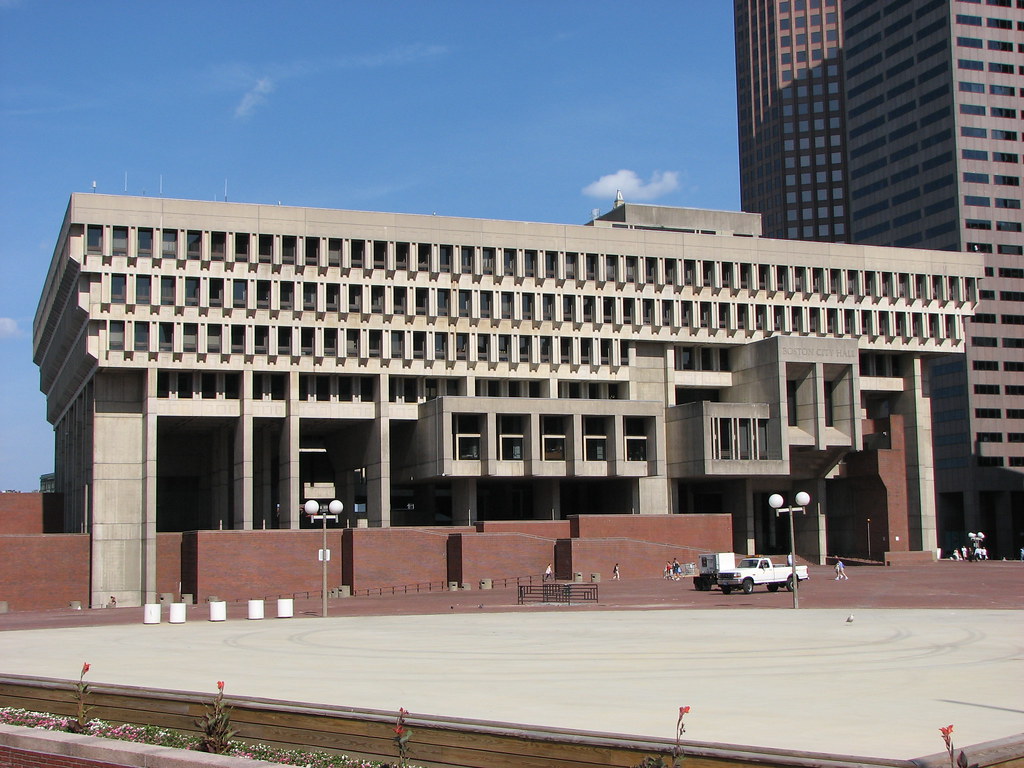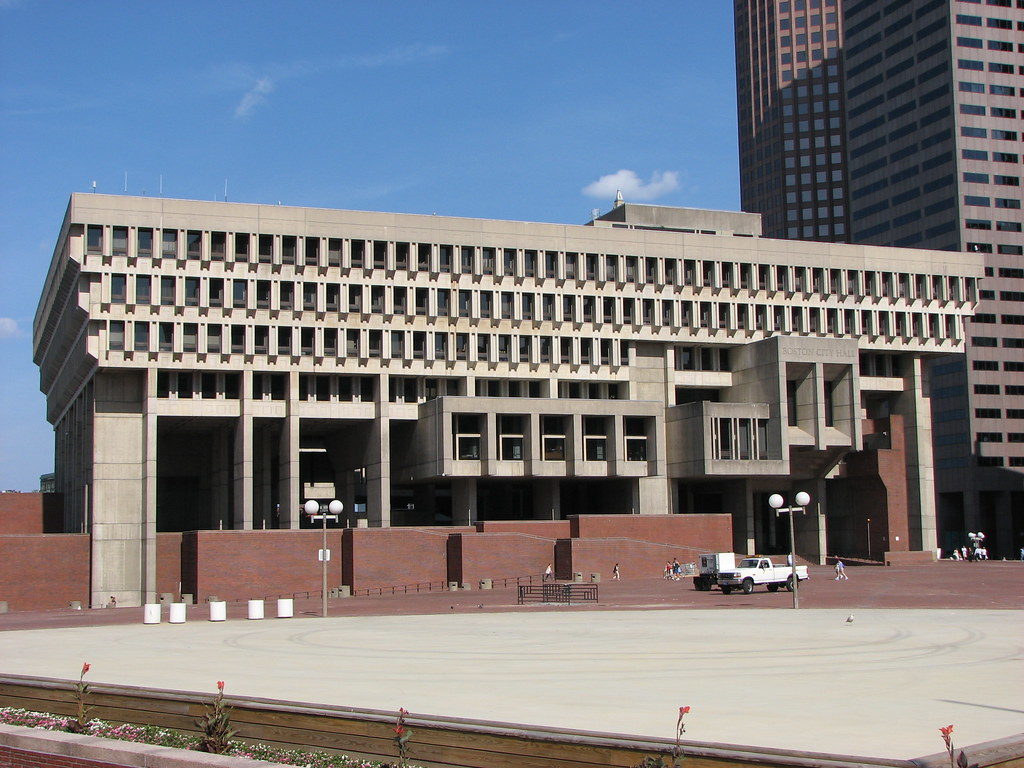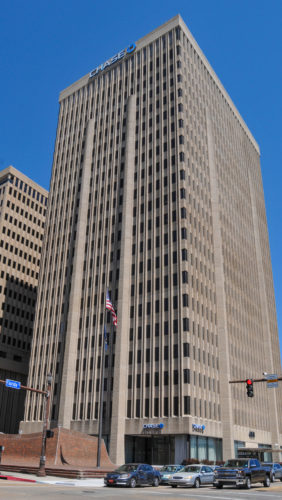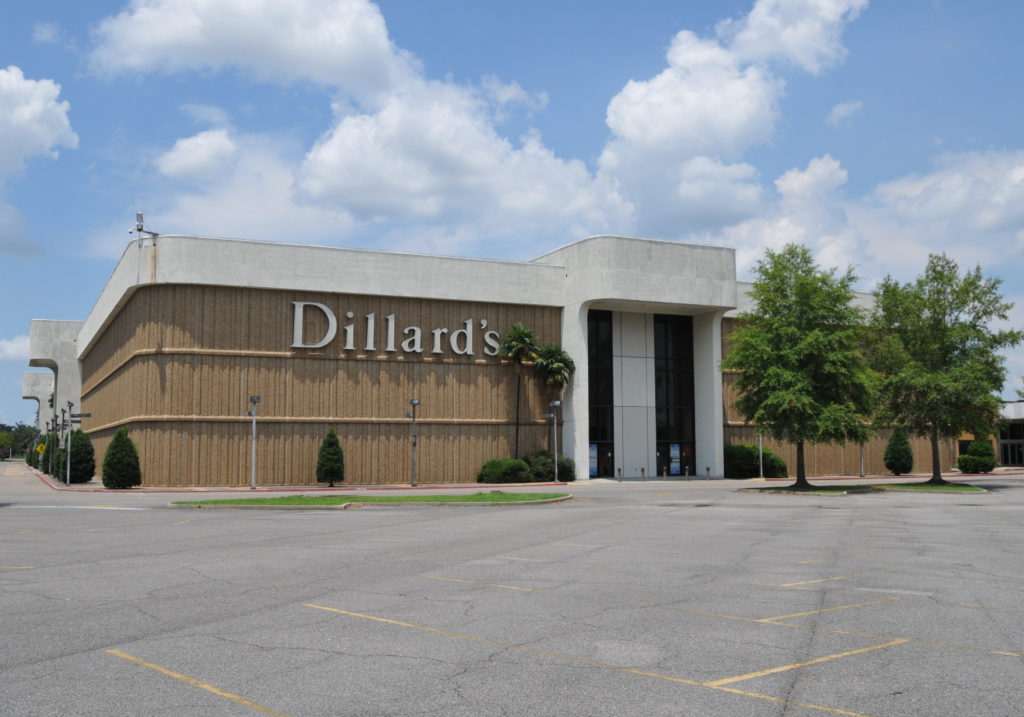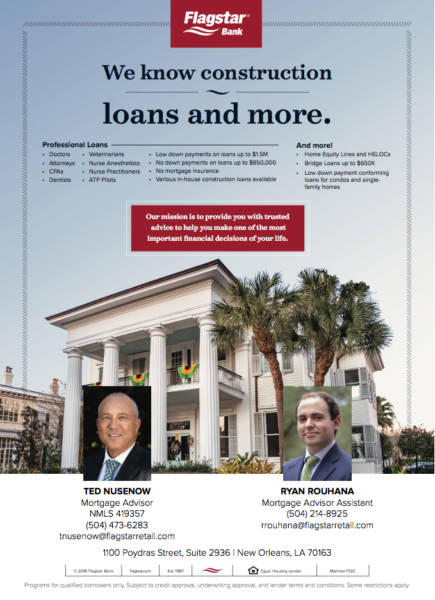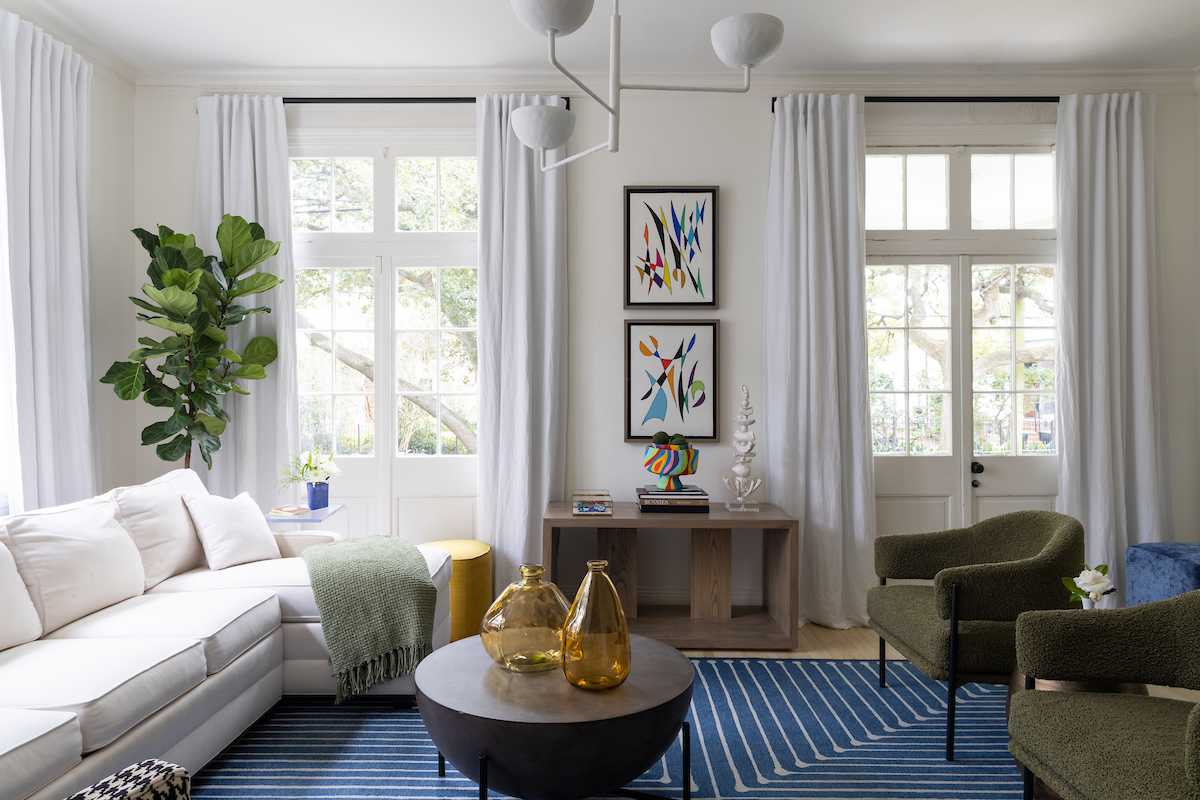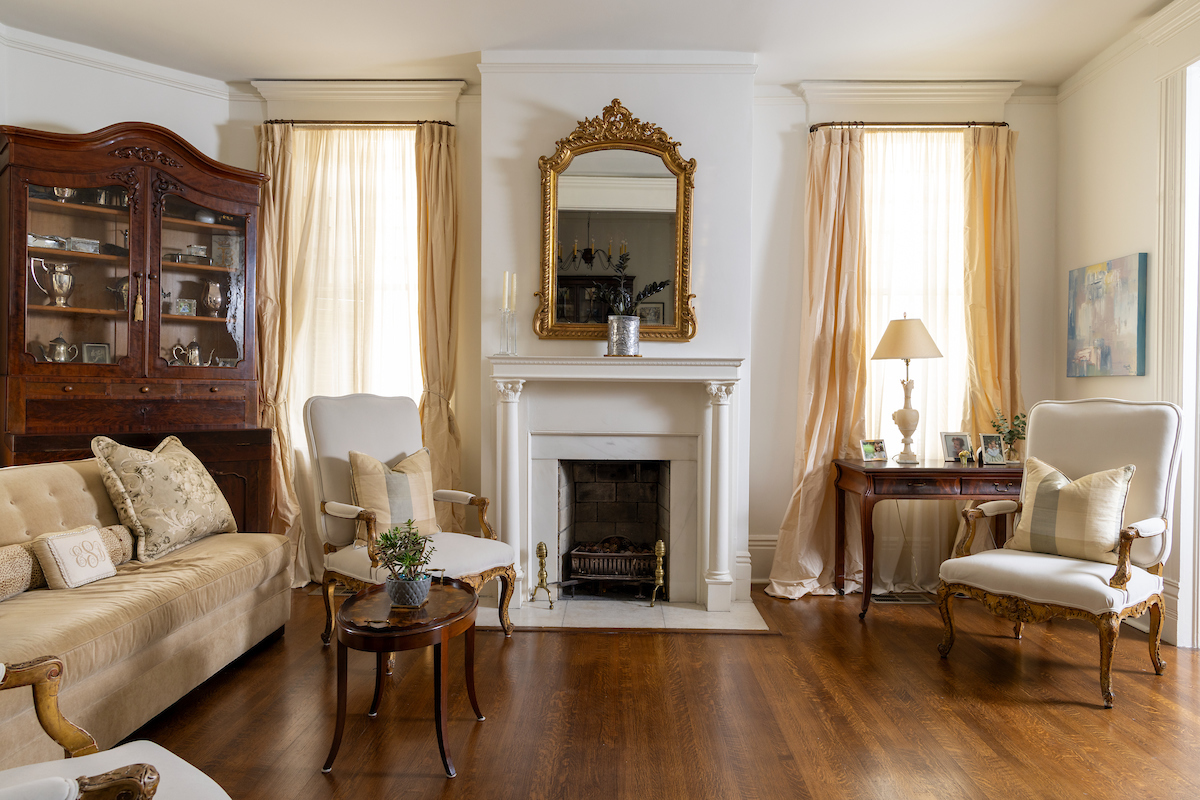This story appeared in the September issue of the PRC’s Preservation in Print magazine. Interested in getting more preservation stories like this delivered to your door monthly? Become a member of the PRC for a subscription!
On July 1, the Boston Globe published an article with the headline: “Learning to love the world’s ugliest building.” The focus of the article was Boston City Hall, arguably the best known and most polarizing example of Brutalist architecture in the United States. It was constructed in 1968.
Now let that headline sink in for a moment: the world’s ugliest building. That’s the hometown newspaper bestowing such a disrespectful designation on a prominent piece of the city’s architecture. But is this sort of attention necessarily a bad thing? After all, didn’t Oscar Wilde write that the only thing worse than being talked about is not being talked about?
Boston City Hall. Photo by Devin Ford.
The Globe’s article on Boston City Hall has generated scores of comments. It came to my attention through a lively Facebook discussion, where I noticed the original article had been shared more than 250 times. The comments varied widely, and in some cases, were contradictory, including: very nice, doesn’t function well, too confusing, never a fan, cover it in plants, can’t stop looking at it, love/hate relationship, so impressive, inhuman in scale, public spaces are terrible, cold majesty, inhumane, overpowering, defy gravity and inexplicable fondness.
While the comments were both positive and negative, the bigger result from the story, I believe, is that it got people talking about this building. Exchanges such as these help create a new narrative about the perceived value of a place, one that focuses not only on the structure and its uses, but also its meaning to us as individuals, its place in our community and the appreciation of it as the work of an artist.
Despite being “strong, powerful, clear sorts of buildings,” said architect and author Alan Hess, Brutalist structures “have fallen out of favor, and from the concrete, we have moved back to glass.” Hess, speaking at the Opening Plenary of the Preserving the Recent Past 3 Conference last spring, urged attendees to consider the Cycles of Taste and their destructive impact on architecture.
Brutalist buildings across the country are facing alteration and demolition at ever increasing rates, even in the midst of burgeoning appreciation for this architectural style driven by social media users. (Check out the Instagram hashtags #SOSBrutalism, #brutalism and #brutalism_appreciation_society.) So how do we, as preservationists, community leaders and concerned citizens, disrupt the Cycle of Taste in Louisiana, which is home to several Brutalist structures, including the Baton Rouge River Center, constructed as the Centroplex during the 1970s; the 1983 Hale Boggs Memorial Bridge in Luling; and the courthouses in Lafayette Parish (1965) and Tangipahoa Parish (1967)?
Louisiana National Bank Building.
How do we help people learn to appreciate this often imposing and impersonal style of architecture? A first step will be to create a historic context for Brutalism in Louisiana. A historic context document is a required component of a National Register of Historic Places nomination narrative. “Historic contexts are those patterns, themes or trends in history by which a specific occurrence, property, or site is understood and its meaning (or significance) within history is made clear,” according to the Louisiana Division of Historic Preservation’s National Register site. “Contexts provide the background necessary to understand why a resource may be significant. A historic context document identifies and explains in detail those patterns, themes or trends that apply within the resource’s state.”
While social media recognition helps drum up attention for these buildings, without in-depth scholarly research, the preservation of these structures, and, in some case, their continued use and potential adaptive reuse, will be unlikely. For these buildings to qualify for potentially lucrative federal historic tax credits, they must first be listed in the National Register of Historic Places, and a historic context for these buildings will be a great asset to listing as many eligible Brutalist buildings as possible.
Advertisement
There are grants available through the Historic Preservation Fund, administered by the Louisiana Division of Historic Preservation, to conduct surveys of these historic buildings, draft National Register nominations, and to create the historic context that will be necessary to preserve Brutalist architecture in Louisiana.
It also will be necessary to create a rehabilitation approach that retains the good qualities of the buildings, master plans and sites, but also acknowledges and finds solutions to their flaws. The Louisiana Division of Historic Preservation’s Tax Incentives staff is working on its first Brutalist rehab project: the Louisiana National Bank Building at 451 Florida St. in Baton Rouge. We are working closely with the owner, architects and consultants to ensure the character of the building, while not widely considered traditionally “historic,” is preserved while it is made compatible for its new commercial, office and residential uses. There are still giant leaps waiting to be made, including convincing property owners not to paint the concrete aggregate exterior finish, to leave the distinctive, vertically raked concrete exposed in elevator lobbies, and to not add crown molding to exposed smooth concrete fascia. It’s a learning experience for all of us, but the ability to incentivize the rehabilitation of these buildings makes it worth it.
Goudchaux’s, now Dillard’s Clearance, was the first anchor store to open at Cortana Mall in Baton Rouge in the early 1970’s. The automotive center, located in the parking lot, was completed in the same style, with vertically raked concrete aggregate, smooth concrete cornice and rounded edges.
Urban renewal projects in the 1960s led to the demolition of broad swaths of historic city centers, where old stone, brick or wood-frame structures were razed to make way for the New Frontier. Embracing a modern aesthetic, pushing the boundaries of design and innovations in materials led to expansive construction programs, some of which relied heavily on Brutalism as their cast-concrete foundation. Today, we must remain alert to the threats of demolition and deferred maintenance, and work towards capturing the public’s imagination and involvement in the retention of these resources. A clear path forward exists, with these steps:
- We must create a historic context for Brutalist architecture in Louisiana, and there are grant funds available to facilitate this.
- We must endeavor to list more of these buildings on the National Register of Historic Places.
- Finally, we must use Federal and State Commercial historic tax credits to appropriately rehabilitate these important buildings and keep them in productive use.
This is how we will brush off barrages on Brutalist architecture and actively disrupt the destructive Cycle of Taste.
Alison F. Saunders is the Tax Incentives Director for the Louisiana Division of Historic Preservation.
Advertisements



